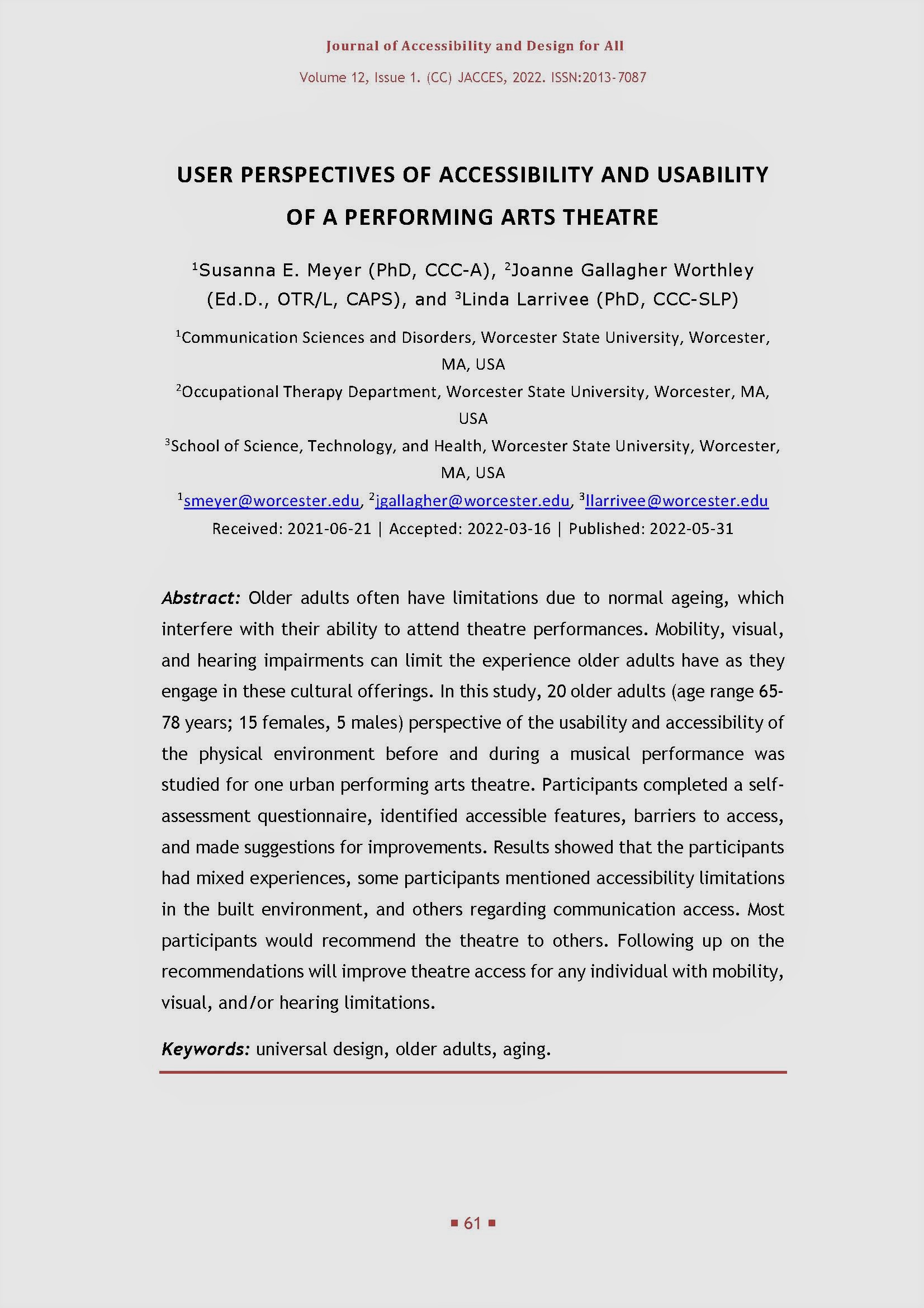User Perspectives of Accessibility and Usability of a Performing Arts Theatre
DOI:
https://doi.org/10.17411/jacces.v12i1.347Abstract
Older adults often have limitations due to normal ageing, which interfere with their ability to attend theatre performances. Mobility, visual, and hearing impairments can limit the experience older adults have as they engage in these cultural offerings. In this study, 20 older adults (age range 65-78 years; 15 females, 5 males) perspective of the usability and accessibility of the physical environment before and during a musical performance was studied for one urban performing arts theatre. Participants completed a self-assessment questionnaire, identified accessible features, barriers to access, and made suggestions for improvements. Results showed that the participants had mixed experiences, some participants mentioned accessibility limitations in the built environment, and others regarding communication access. Most participants would recommend the theatre to others. Following up on the recommendations will improve theatre access for any individual with mobility, visual, and/or hearing limitations.References
Carr, K., Weir, P.L., Azar, D. & Azar, N.R. (2013). Universal design: A step toward successful aging. Journal of Aging Research, Article ID 324624. https://doi.org/10.1155/2013/324624
Centers for Disease Control and Prevention (2020). Disability impacts all of us. https://www.cdc.gov/ncbddd/disabilityandhealth/infographic-disability-impacts-all.html
Center for Universal Design. (1997). The principles of universal design, versión 2.0. Raleigh, NC. North Carolina State University. https://projects.ncsu.edu/ncsu/design/cud/about_ud/udprinciplestext.htm
Chen, H. (2013). A study of older people with disability: Evidence from two cosmopolitan cities. Ageing International, 38, 328–342. https://doi.org/10.1007/s12126-012-9164-1
Cluley, V. & Radnor, Z. (2020). Progressing the conceptualization of value co-creation in public service organizations. Perspectives on Public Management and Governance, 3(3), 211–221. https://doi.org/10.1093/ppmgov/gvz024
Crews, J.E. & Campbell,V.A. (2004). Vision impairment and hearing loss among community-dwelling older Americans:Implications for health and functioning. American Journal of Public Health, 94, 823-829. https://doi.org/10.2105/AJPH.94.5.823
Gallistl V. (2021). Cultural exclusion in old-age: A social exclusion perspective on cultural practice in later life. In K.Walsh, T. Scharf, S. Van Regenmortel,& A. Wanka (Eds.), Social exclusion in later life. International Perspectives on Aging, 28, Spring, Cham.
https://link.springer.com/chapter/10.1007%2F978-3-030-51406-8_20
The Hanover Theatre & Conservatory for Performing Arts. (2021a). Accessibility. Accessibility - Hanover Theatre and Conservatory . https://thehanovertheatre.org/plan-your-visit/accessibility/
The Hanover Theatre & Conservatory for the Performing Arts. (2021b). https://thehanovertheatre.org/about/the-building/
Jennings, M.B. (2009). Hearing accessibility and assistive technology use by older adults: Application of universal design principles to hearing. Proceedings of the Second International Adult Conference. Second International Adult Conference, Chicago, United States, 16-18 November 2009. Staefa, Switzerland: Phonak. https://www.phonakpro.com/com/en/training-events/events/past-events/2009/adult-conference-chicago.html
Kattenstroth, J-C., Kolankowska, I., Kalish, T., & Dinse, H.R. (2010). Superior sensory, motor, and cognitive performance in elderly individuals with multi-year dancing activities. Frontiers in Aging Neuroscience, 2, 1-9. https://doi.org/10.3389/fnagi.2010.00031
Krampe, R. T. (2002). Aging, expertise and fine motor movement. Neuroscience & Biobehavioral Reviews, 26(7), 769–776 https://doi.org/10.1016/s0149-7634(02)00064-7
Kraus, L., Lauer, E., Coleman, R., & Houtenville, A. (2018). 2017 Disability Statistics Annual Report. Durham, NH: University of New Hampshire. https://files.eric.ed.gov/fulltext/ED583258.pdf
Meeks, S., Shryock, S.K., & Vandenbroucke, R., J. (2018). Theatre involvement and well-being, age differences, and lessons from long-time subscribers. The Gerontologist, 58(2), 278–289. https://doi.org/10.1093/geront/gnx029
Meyer, S, Larrivee, L., Veneziano-Korzec, A., & Stacy, K. (2017). Improving art museum accessibility for adults with acquired hearing loss. American Journal Audiology, 26(1), 10-17. https://doi.org/10.1044/2016_AJA-15-0084
National Disability Authority. (2014). The Centre for Excellence in Universal Design. https://universaldesign.ie/
National Endowment for the Arts (NEA) and the National Center for Creative Aging. (2016). The Summit on Creativity and Aging in America. The Summit on Creativity and Aging in America (arts.gov). https://www.arts.gov/sites/default/files/summit-on-creative-aging-feb2016.pdf
Portney, L. G., & Watkins, M.P. (2015). Foundations of Clinical Research - Applications to Practice. (3rd ed.). Philadelphia, PA: F. A. Davis. ISBN-10: 0131716409.
Rowe, J., & Kahn, R. (1997). Successful aging. The Gerontologist, 37(4), 433–440. https://doi.org/10.1093/geront/37.4.433
Rowe, J. B., Sasa, H.S., Filipovic, R., Cordivari, C., Gerschlager, W., Rothwell, J., & Frackowiak, R. (2006). Aging is associated with contrasting changes in local and distant cortical connectivity in the human motor system. Neuroimage, 32(2), 747-760. https://doi.org/10.1016/j.neuroimage.2006.03.061
Stark, S., Hollingsworth, H. H., Morgan, K. A., & Gray, D. B. (2007). Development of a measure of receptivity of the physical environment. Disability and Rehabilitation, 29(2), 123–137. https://doi.org/10.1080/09638280600731631
Tye-Murray, N. (2020). Foundations of Aural Rehabilitation. Children, Adults, and Their Family Members (5th Ed). San Diego, CA: Plural Publishing. ISBN-10: 1635500737.
United Nations. (2006). United Nations Convention on the Rights of Persons with Disabilities.
https://www.un.org/disabilities/documents/convention/convention_accessible_pdf.pdf
US Department of Justice. (2010, September). Guidance on the 2010 ADA Standards for Accessible Design. https://www.ada.gov/regs2010/2010ADAStandards/Guidance2010ADAstandards.html

Downloads
Published
How to Cite
Issue
Section
License
Copyright (c) 2022 Susanna E. Meyer, Ph.D., CCC-A, Joanne Gallagher Worthley Ed.D., OTR/L, CAPS, Linda Larrivee, Ph.D., CCC-SLP

This work is licensed under a Creative Commons Attribution-NonCommercial 4.0 International License.
- Authors retain copyright and grant the journal right of first publication with the work simultaneously licensed under a Creative Commons Attribution License that allows others to share or adapt the work with an acknowledgment of the work's authorship and initial publication in this journal. Use of the work for commercial purposes are not allowed.
- Authors are able to publish the journal's published version of the work in other media (e.g., post it to an institutional repository or publish it in a book), as far as they inform the Journal of Accessibility and Design for All of that fact. When publishing their work in other sources, authors must mention the name of the Journal of Accessibility and Design for All, its ISSN, the number and issue in which the article was published and a link to the main page of the Journal of Accessibility and Design for All. Optionally, they can also include a link to the article published in the Journal of Accessibility and Design for All.
- Authors are permitted and encouraged to post their work online (e.g., in institutional repositories or on their website), as it can lead to productive exchanges, as well as earlier and greater citation of published work.



